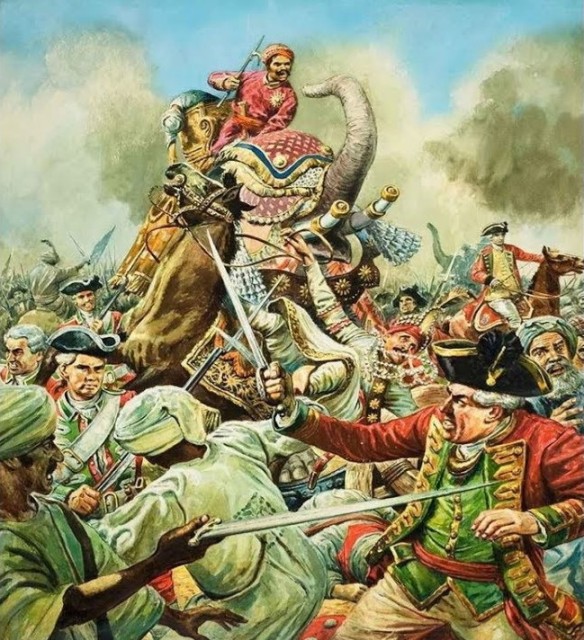
Shuja-ud-Dowlah, the Moghul vizier and Nawab of Oudh, and Mir Kasim, Nawab of Bengal, assembled some 50,000 men to reconquer Bengal, which had fallen to the HEIC [Honourable East India Company] after the Battle of Plassey. The offensive was met by a British force of 7000 under Major (later Sir Hector) Munro, on the south bank of the Ganges at Buxar near Shahabad in Bihar. After a violent conflict the Indians retreated with a loss of 2000 men, but their force was much reduced by desertions as well. This defeated Mir Kasim’s claim to Bengal. It also raised the Co’s prestige and heavily depressed that of the Moghul govt. In practice the victory made the Co. a govt. as well as a trading concern, though it did its best to conceal the fact.
The Battle of Buxar was fought on 22 October 1764, between the forces under the command of the British East India Company, led by Hector Munro, and the combined armies of Mir Qasim, the Nawab of Bengal till 1763. Mir Jafar was made the Nawab of Bengal for a second time in 1763 by the Company, just after the battle. After being defeated in 4 battles in Katwa, Giria and Udaynala, the Nawab of Awadh Shuja-ud-Daula and the Mughal Emperor Shah Alam II, accompanied by Raja Balwant Singh of Kashi made an alliance with Mir Qasim. The battle was fought at Buxar, a “small fortified town” within the territory of Bihar, located on the banks of the Ganga river about 130 kilometres (81 mi) west of Patna; it was a decisive victory for the British East India Company. The war was brought to an end by the Treaty of Allahabad in 1765. Battle
The British army engaged in the fighting numbered 7,072 comprising 859 British, 5,297 Indian sepoys and 918 Indian cavalry. The alliance army’s numbers were estimated to be over 40,000. According to other sources, the combined army of the Mughals, Awadh and Mir Qasim consisting of 40,000 men was defeated by a British army comprising 10,000 men. The Nawabs had virtually lost their military power after the battle of Buxar.
The lack of basic co-ordination among the three disparate allies was responsible for their decisive defeat.
Mirza Najaf Khan commanded the right flank of the Mughal imperial army and was the first to advance his forces against Major Hector Munro at daybreak; the British lines formed within twenty minutes and reversed the advance of the Mughals. According to the British, Durrani and Rohilla cavalry were also present and fought during the battle in various skirmishes. But by midday, the battle was over and Shuja-ud-Daula blew up large tumbrils and three massive magazines of gunpowder.
Munro divided his army into various columns and particularly pursued the Mughal Grand Vizier Shuja-ud-Daula the Nawab of Awadh, who responded by blowing up his boat-bridge after crossing the river, thus abandoning the Mughal Emperor Shah Alam II and members of his own regiment. Mir Qasim also fled with his 3 million rupees worth of Gemstones and later died in poverty in 1777. Mirza Najaf Khan reorganised formations around Shah Alam II, who retreated and then chose to negotiate with the victorious British.
Historian John William Fortescue claimed that the British casualties totalled 847: 39 killed and 64 wounded from the European regiments and 250 killed, 435 wounded and 85 missing from the East India Company’s sepoys. He also claimed that the three Indian allies suffered 2,000 dead and that many more were wounded. Another source says that there were 69 European and 664 sepoy casualties on the British side and 6,000 casualties on the Mughal side. The victors captured 133 pieces of artillery and over 1 million rupees of cash. Immediately after the battle Munro decided to assist the Marathas, who were described as a “warlike race”, well known for their relentless and unwavering hatred towards the Mughal Empire and its Nawabs and Mysore. Aftermath
The British victory at Buxar had “at one fell swoop”, disposed of the three main scions of Mughal power in Upper India. Mir Kasim [Qasim] disappeared into an impoverished obscurity. Shah Alam realigned himself with the British, and Shah Shuja [Shuja-ud-Daula] fled west hotly pursued by the victors. The whole Ganges valley lay at the Company’s mercy; Shah Shuja eventually surrendered; henceforth Company troops became the power-brokers throughout Oudh as well as Bihar”.
MIR JAFAR (?-1765) the greatest noble at the Court of the Nawab Suraj-u-Dowlah of Bengal, conspired with the Jagath Seth to depose him and secured the HEIC’s help by promising large sums of compensation for his seizure of Calcutta. Naturally the HEIC agreed and so Mir Jafar’s troops stood aside, while Clive defeated the Nawab at Plassey. On elevation he granted the zamindari of the XXIV Parganas and undertook an offensive and defensive alliance with the HEIC. Extravagance and the onerous financial terms of his agreements drove him towards bankruptcy, and he entered into an intrigue with the Dutch which came to nothing. Meanwhile Clive had gone to England and Mir Jafar’s son had died. The British accordingly deposed him in favour of MIR KASIM (?-?1767) his son-in-law, who ceded the three districts of Burdwan, Midnapore and Chittagong but was a more efficient and sensible administrator than Mir Jafar. In particular to regularise the wholesale abuses of private trade by HEIC officials he agreed a new tax regime (9% ad valorem on the officials, 40% on the rest) with the Pres. of the Calcutta council but the council demanded 2% and on salt only. Thereupon he remitted all duties, which enabled the industrious Bengalis to undersell the British. War followed. Mir Kasim was driven into Oudh where he, with the Nawab of Oudh, were defeated at Buxar (Oct. 1764). Mir Jafar, was meanwhile reinstated upon financial terms which were much more onerous than before, for he had to pay for the war against his son-in-law, restrict his duty on European trading to 2% and pay out enormous sums in presents.